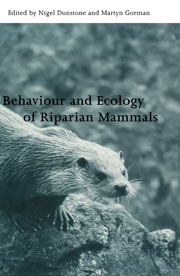Book contents
- Frontmatter
- Contents
- List of contributors
- Preface
- 1 Adaptations to the semi-aquatic habit and habitat
- 2 Physiological challenges in semi-aquatic mammals: swimming against the energetic tide
- 3 Diving capacity and foraging behaviour of the water shrew (Neomys fodiens)
- 4 Habitat use by water shrews, the smallest of amphibious mammals
- 5 The importance of the riparian environment as a habitat for British bats
- 6 A preliminary study of the behaviour of the European mink Mustela lutreola in Spain, by means of radiotracking
- 7 The demography of European otters Lutra lutra
- 8 Habitat use and conservation of otters (Lutra lutra) in Britain: a review
- 9 The relationship between riverbank habitat and prey availability and the distribution of otter (Lutra lutra) signs: an analysis using a geographical information system
- 10 Influence of altitude on the distribution, abundance and ecology of the otter (Lutra lutra)
- 11 Diets of semi-aquatic carnivores in northern Belarus, with implications for population changes
- 12 Otter (Lutra lutra) prey selection in relation to fish abundance and community structure in two different freshwater habitats
- 13 Diet, foraging behaviour and coexistence of African otters and the water mongoose
- 14 Feeding ecology of the smooth-coated otter Lutra perspicillata in the National Chambal Sanctuary, India
- 15 Population trends of hippopotami in the rivers of the Kruger National Park, South Africa
- 16 Reproductive strategies of female capybaras: dry-season gestation
- 17 The continuing decline of the European mink Mustela lutreola: evidence for the intraguild aggression hypothesis
- 18 Otters and pollution in Spain
- 19 The rapid impact of resident American mink on water voles: case studies in lowland England
- 20 Status, habitat use and conservation of giant otter in Peru
- Index
13 - Diet, foraging behaviour and coexistence of African otters and the water mongoose
Published online by Cambridge University Press: 03 May 2010
- Frontmatter
- Contents
- List of contributors
- Preface
- 1 Adaptations to the semi-aquatic habit and habitat
- 2 Physiological challenges in semi-aquatic mammals: swimming against the energetic tide
- 3 Diving capacity and foraging behaviour of the water shrew (Neomys fodiens)
- 4 Habitat use by water shrews, the smallest of amphibious mammals
- 5 The importance of the riparian environment as a habitat for British bats
- 6 A preliminary study of the behaviour of the European mink Mustela lutreola in Spain, by means of radiotracking
- 7 The demography of European otters Lutra lutra
- 8 Habitat use and conservation of otters (Lutra lutra) in Britain: a review
- 9 The relationship between riverbank habitat and prey availability and the distribution of otter (Lutra lutra) signs: an analysis using a geographical information system
- 10 Influence of altitude on the distribution, abundance and ecology of the otter (Lutra lutra)
- 11 Diets of semi-aquatic carnivores in northern Belarus, with implications for population changes
- 12 Otter (Lutra lutra) prey selection in relation to fish abundance and community structure in two different freshwater habitats
- 13 Diet, foraging behaviour and coexistence of African otters and the water mongoose
- 14 Feeding ecology of the smooth-coated otter Lutra perspicillata in the National Chambal Sanctuary, India
- 15 Population trends of hippopotami in the rivers of the Kruger National Park, South Africa
- 16 Reproductive strategies of female capybaras: dry-season gestation
- 17 The continuing decline of the European mink Mustela lutreola: evidence for the intraguild aggression hypothesis
- 18 Otters and pollution in Spain
- 19 The rapid impact of resident American mink on water voles: case studies in lowland England
- 20 Status, habitat use and conservation of giant otter in Peru
- Index
Summary
Introduction
In Africa the Eurasian otter, Lutra lutra, occurs in streams flowing from the Atlas Mountains in the three north African countries of Morocco, Algeria, and Tunisia. There are no otters in the arid Sahara region. Three endemic otters occur in the areas of sub–Saharan Africa that receive an annual rainfall in excess of about 500 mm. They are the Cape clawless otter, Aonyx capensis, the Congo clawless otter, Aonyx congica, and the spotted–necked otter, Lutra maculicollis. Occurring in all of the habitats in which the otters have been recorded is a fourth endemic amphibious carnivore, the water mongoose, Atilax paludinosus (Fig. 13.1). In this chapter we will not deal with the Eurasian otter. In order to synthesize much recent work on African otters and water mongooses, particularly in southern Africa, a review concerning diet, foraging behaviour and coexistence of African otters and the water mongoose is presented in this chapter.
Very little information is available on Aonyx congica. It occurs in rain forests and lowland swamp forests of the Congo River Basin, as well as the forests and wetland areas of Rwanda, Burundi and south–western Uganda (Rowe–Rowe, 1990). Pygmies in the Ituri Forest of Zaire stated that A. congica lives on fish and crabs (Capaneto & Germi, 1989), while Baranga (1995) associated the distribution of this otter with habitats in which there was an abundance of freshwater crabs, giant earthworms, mudfish and clawed toads (Xenopus sp.).
- Type
- Chapter
- Information
- Behaviour and Ecology of Riparian Mammals , pp. 215 - 228Publisher: Cambridge University PressPrint publication year: 1998
- 9
- Cited by



